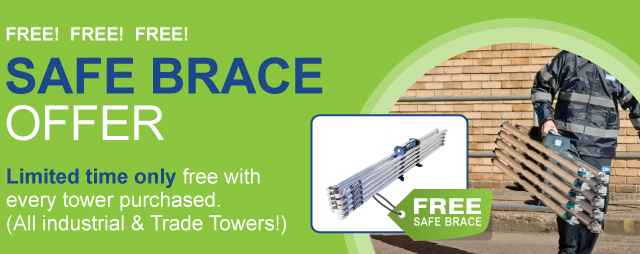In the world of construction and maintenance work, access to elevated areas is often necessary. To safely and efficiently accomplish this, various tools and equipment are used, including scaffolding and scaffold towers. While they both serve the purpose of providing a stable platform for workers to perform tasks at heights, there are several key differences between the two. Understanding these differences is crucial for selecting the right option for a particular job.
Understanding the Basics: Scaffolding and Scaffold Towers
Defining Scaffolding
Scaffolding is a temporary structure consisting of platforms, tubes, and couplers that are assembled to create a working platform at different heights. It is a versatile and modular system that can be customised to suit the specific needs of a project. Scaffolding is widely used in construction, renovation, and maintenance activities.
When it comes to construction projects, safety and efficiency are of utmost importance. Scaffolding plays a crucial role in ensuring that workers have a stable and secure platform to perform their tasks. It provides a temporary framework that allows workers to access hard-to-reach areas, such as high ceilings or building facades.
One of the key advantages of scaffolding is its adaptability. It can be easily adjusted and reconfigured to accommodate different project requirements. Whether it’s a small-scale renovation or a large-scale construction project, scaffolding can be tailored to provide the necessary support and accessibility.
Moreover, scaffolding is designed to distribute weight evenly, ensuring the safety of workers and preventing structural damage. It is constructed using sturdy materials, such as steel or aluminium, which can withstand heavy loads and adverse weather conditions.
What is a Scaffold Tower?
A scaffold tower, on the other hand, is a freestanding structure made up of prefabricated components that are specifically designed for quick and easy assembly. Scaffold towers are often used for tasks that require mobility and flexibility, such as painting, cleaning, and light maintenance work. They provide a stable and secure platform without the need for additional support from a building or structure.
Imagine a scenario where a building’s exterior needs a fresh coat of paint. Instead of using traditional scaffolding, which requires extensive setup and relies on the building’s structure for support, a scaffold tower can be a more efficient solution. With its modular design and lightweight components, a scaffold tower can be easily transported and assembled at the desired location.
Scaffold towers are equipped with features that enhance safety and convenience. They often come with guardrails, non-slip platforms, and locking mechanisms to prevent accidents and ensure stability. Additionally, scaffold towers can be adjusted to different heights, allowing workers to reach various areas without the need for additional equipment or scaffolding.
Another advantage of scaffold towers is their versatility. They can be used both indoors and outdoors, making them suitable for a wide range of projects. Whether it’s a residential painting job or a commercial cleaning task, scaffold towers provide a practical and cost-effective solution.
Key Differences Between Scaffolding and Scaffold Towers
Structural Differences
One of the primary differences between scaffolding and scaffold towers is their structural design. Scaffolding typically consists of multiple horizontal and vertical tubes connected by couplers, forming a stable and modular framework. This design allows for flexibility and customization, as the tubes can be easily adjusted and rearranged to fit the specific requirements of the construction project. Additionally, the couplers provide a secure connection between the tubes, ensuring the stability and safety of the scaffold.
In contrast, scaffold towers are pre-engineered units that feature integrated frames and platforms, offering easy setup and dismantling. These towers are designed to be self-supporting, with built-in stabilisers and guardrails. The integrated frames provide a rigid structure, eliminating the need for additional couplers or connectors. This design simplifies the assembly process, making scaffold towers a popular choice for projects that require quick installation and mobility.
Functionality and Use
Another important distinction is the functionality and intended use of these two systems. Scaffolding is known for its versatility and ability to adapt to complex structures and uneven terrains. It can be erected around buildings, bridges, and other structures, providing a safe and stable working platform for construction workers. The modular design of scaffolding allows for easy customization, enabling workers to reach different heights and access hard-to-reach areas. Additionally, scaffolding can support heavy loads, making it suitable for projects that involve the installation of large equipment or materials.
Scaffold towers, on the other hand, are lightweight and portable, making them ideal for tasks that involve frequent movement and quick assembly. These towers are often used in industries such as painting, maintenance, and event management, where workers need to access different areas within a short period of time. The compact and mobile nature of scaffold towers allows for easy transportation and setup, saving time and effort. Despite their lightweight design, scaffold towers are still sturdy and reliable, providing a safe working platform for workers.
Furthermore, scaffold towers are often equipped with additional features such as adjustable platforms, wheels, and locking mechanisms. These features enhance the functionality and convenience of scaffold towers, allowing workers to easily adjust the height of the platform, move the tower to different locations, and secure it in place during operation. The versatility and ease of use make scaffold towers a popular choice for projects that require flexibility and mobility.
Pros and Cons of Scaffolding
Scaffolding is a crucial component in the construction industry, providing a temporary structure that supports workers and materials during building projects. It offers several advantages and disadvantages that need to be considered. Let’s take a closer look at the pros and cons of scaffolding.
Advantages of Scaffolding
Scaffolding offers several advantages that make it an essential tool in construction projects. Firstly, its modular design allows for customization and flexibility on the job site. The ability to adjust the height and configuration of scaffolding makes it suitable for projects of all scales, whether it’s a small residential building or a large commercial complex.
Additionally, scaffolding provides a spacious platform for workers, enabling them to move around freely and access different areas of the building. This efficient movement not only saves time but also enhances productivity. With scaffolding, workers can easily reach heights that would otherwise be challenging or unsafe to access.
Another significant advantage of scaffolding is its sturdy construction, which ensures stability and safety while working at heights. The strong and durable materials used in scaffolding provide a secure platform for workers to perform their tasks without the fear of accidents or injuries. This safety factor is of utmost importance in the construction industry, where working at heights is a common occurrence.
Disadvantages of Scaffolding
Despite its numerous benefits, scaffolding also has its limitations that need to be considered. One of the main disadvantages is the time and effort required for setting up scaffolding, especially for complex structures. Erecting scaffolding involves careful planning, precise measurements, and skilled labour to ensure its stability and safety. This process can be time-consuming, potentially delaying the overall project timeline.
Moreover, scaffolding is bulky and requires additional storage space when not in use. Construction sites often have limited space, and finding room to store scaffolding components can be a challenge. This issue adds to the logistical complexities of construction projects, as proper storage and transportation of scaffolding are essential.
Transporting scaffolding components can be another hurdle, especially when the construction site has limited access. The size and weight of scaffolding materials may require specialised equipment or additional manpower to transport them safely. This logistical challenge can increase project costs and time if not properly managed.
Furthermore, assembling and dismantling scaffolding can be labour-intensive tasks that require skilled workers and proper training. The complexity of scaffolding structures demands expertise in order to ensure its stability and safety. Improper assembly or dismantling can lead to accidents and injuries, highlighting the importance of having trained professionals handle these tasks.
In conclusion, scaffolding offers several advantages in terms of customization, flexibility, spaciousness, and safety. However, it also comes with disadvantages such as the time and effort required for setup, the need for additional storage space, logistical challenges in transportation, and the labour-intensive nature of assembly and dismantling. Understanding these pros and cons is crucial for construction professionals to make informed decisions regarding the use of scaffolding in their projects.
Pros and Cons of Scaffold Towers
Benefits of Scaffold Towers
Scaffold towers offer several advantages over traditional scaffolding systems. Firstly, scaffold towers are highly portable, enabling ease of transportation between different locations. This means that construction workers can easily move the scaffold tower from one area of the job site to another, without the need for disassembling and reassembling the entire structure. This portability not only saves time but also allows for greater flexibility in completing construction tasks efficiently.
In addition to their portability, scaffold towers are known for their quick and hassle-free setup. With pre-assembled components, construction workers can easily and rapidly erect the scaffold tower, reducing downtime and increasing productivity. This is especially beneficial in time-sensitive projects where every minute counts.
Another significant benefit of scaffold towers is the stability and safety they provide. Integrated frames and platforms ensure that the scaffold tower remains sturdy and secure during construction activities. This reduces the risk of accidents and falls, providing a safer working environment for construction workers. The stability of scaffold towers also allows workers to focus on their tasks without worrying about the structure’s integrity.
Drawbacks of Scaffold Towers
While scaffold towers are advantageous in many ways, they also come with a few drawbacks. One limitation of scaffold towers is their height and load-bearing capacity. Compared to traditional scaffolding, scaffold towers are generally more limited in terms of the maximum height they can reach and the amount of weight they can support. This makes them less suitable for larger construction projects where a significant working area is required or when heavy equipment needs to be used at greater heights.
Additionally, scaffold towers may not be as adaptable to uneven terrains or complex structures as scaffolding. The fixed design of scaffold towers can make it challenging to set up on surfaces that are not level or have irregularities. In such cases, traditional scaffolding may be a more suitable option as it can be adjusted and customised to fit the specific requirements of the construction site.
Despite these limitations, scaffold towers remain a popular choice for many construction projects due to their portability, quick setup, and stability. It is essential for construction professionals to carefully assess the specific needs of their project and consider the advantages and disadvantages of scaffold towers before making a decision.
Safety Considerations for Scaffolding and Scaffold Towers
Safety Measures for Scaffolding
When working with scaffolding, safety should always be a top priority. Erecting a stable and secure scaffolding structure is essential to prevent accidents and ensure the well-being of workers. Proper training and supervision are crucial to minimise risks associated with working at heights. Regular inspection and maintenance of scaffolding components are also necessary to identify and address any potential hazards.
Ensuring Safety with Scaffold Towers
Similarly, safety measures must be implemented when using scaffold towers. It is important to follow the manufacturer’s instructions during assembly and disassembly to maintain structural integrity. Utilising proper bracing and stabilisers can enhance stability and prevent tipping. Adequate training and the use of personal protective equipment, such as harnesses and guardrails, are also vital for the safety of workers using scaffold towers.
Conclusion
In conclusion, the choice between scaffolding and scaffold towers depends on the specific requirements of a project. Scaffolding offers versatility and adaptability, making it suitable for large-scale construction projects, while scaffold towers provide mobility and ease of setup for tasks that require frequent movement. Regardless of the option chosen, ensuring safety and adhering to best practices is essential to minimise risks and create a secure working environment at heights.


